Processes Associated with Multiphase Dolomitization and Other Related Diagenetic Events in the Jurassic Samana Suk Formation, Himalayan Foreland Basin, NW Pakistan
Abstract
:1. Introduction
2. Geological Setting
3. Methodology
4. Results
4.1. Field Investigations and Petrographic Studies
4.2. Geochemistry
4.2.1. Major and Trace Elements
4.2.2. Stable C and O Isotopic Studies
4.2.3. Radiogenic Sr Isotopes
4.2.4. Sr Concentration
4.3. Fluid Inclusion Analysis
5. Discussion
5.1. Origin of Dolomite Phases
5.2. Origin of Dolomitizing Fluids
5.3. Dolomitizing Model
6. Conclusions
- Dolomitization in the Jurassic Samana Suk Formation is a multiphase process, as revealed by field observations, petrographic studies, and geochemical analysis.
- The first phase of dolomitization is initiated soon after the deposition and initial compaction of sediments because of altered seawater, which is supported by their presence as strata-bound units, small crystal size, higher Na concentration, low Fe and Mn concentration, non-depleted δ18O signatures, and non-radiogenic 87Sr/86Sr ratios.
- The second phase of dolomitization resulted from hydrothermal sources as evidenced by the cross-cutting relationship in the field, large planer to non-planer crystal shape, lower concentration of Na and higher concentration of Mn and Fe, depleted δ18O values, and radiogenic 87Sr/86Sr ratios.
- The fluid inclusion analysis of saddle dolomite cement gives high temperature and salinity values, which suggest their formation from hydrothermal brines of high salinity.
- The possible heat source can be linked to the hotspot igneous activity, which caused the domal uplift of the Indian plate during the Late Cretaceous. This causes activation of deep-seated faults, which causes the basement rich in brine fluids to move upward in the carbonate succession preferentially along fractures and dolomitize the succession.
- Evaporite (gypsum, anhydrite) beds present in the Pre-Cambrian basement rocks can be the possible source for providing Mg-rich fluids during the burial of the carbonates.
- Fractures and faults related to the Himalayan orogeny are steeply cross-cutting the limestone/dolostone succession. They are later filled with blocky calcite cement during uplift phases. The depleted δ18O values, radiogenic 87Sr/86Sr ratios, and high homogenization temperature suggest their origin from hydrothermal sources.
Author Contributions
Funding
Data Availability Statement
Acknowledgments
Conflicts of Interest
References
- Ahmad, I.; Shah, M.M.; Janjuhah, H.T.; Trave, A.; Antonarakou, A.; Kontakiotis, G. Multiphase Diagenetic Processes and Their Impact on Reservoir Character of the Late Triassic (Rhaetian) Kingriali Formation, Upper Indus Basin, Pakistan. Minerals 2022, 12, 1049. [Google Scholar] [CrossRef]
- Warren, J. Dolomite: Occurrence, evolution and economically important associations. Earth-Sci. Rev. 2000, 52, 1–81. [Google Scholar] [CrossRef]
- Machel, H.G. Concepts and models of dolomitization: A critical reappraisal. Geol. Soc. Lond. Spec. Publ. 2004, 235, 7–63. [Google Scholar] [CrossRef]
- Rahim, H.u.; Shah, M.M.; Corbella, M.; Navarro-Ciurana, D. Diagenetic evolution and associated dolomitization events in the middle Jurassic Samana Suk Formation, Lesser Himalayan Hill Ranges, NW Pakistan. Carbonates Evaporites 2020, 35, 101. [Google Scholar] [CrossRef]
- Cantrell, D.; Swart, P.; Hagerty, R. Genesis and characterization of dolomite, Arab-D reservoir, Ghawar field, Saudi Arabia. GeoArabia 2004, 9, 11–36. [Google Scholar] [CrossRef]
- Davies, G.R.; Smith, L.B., Jr. Structurally controlled hydrothermal dolomite reservoir facies: An overview. AAPG Bull. 2006, 90, 1641–1690. [Google Scholar] [CrossRef]
- Mahboubi, A.; Nowrouzi, Z.; Al-Aasm, I.; Moussavi-Harami, R.; Mahmudy-Gharaei, M. Dolomitization of the Silurian Niur Formation, Tabas block, east central Iran: Fluid flow and dolomite evolution. Mar. Pet. Geol. 2016, 77, 791–805. [Google Scholar] [CrossRef]
- Shelton, K.L.; Cavender, B.D.; Perry, L.E.; Schiffbauer, J.D.; Appold, M.S.; Burstein, I.; Fike, D.A. Stable isotope and fluid inclusion studies of early Zn-Cu-(Ni-Co)-rich ores, lower ore zone of Brushy Creek mine, Viburnum Trend MVT district, Missouri, USA: Products of multiple sulfur sources and metal-specific fluids. Ore Geol. Rev. 2020, 118, 103358. [Google Scholar] [CrossRef]
- Gasparrini, M.; Bakker, R.J.; Bechstädt, T. Characterization of dolomitizing fluids in the Carboniferous of the Cantabrian Zone (NW Spain): A fluid-inclusion study with cryo-Raman spectroscopy. J. Sediment. Res. 2006, 76, 1304–1322. [Google Scholar] [CrossRef]
- Vandeginste, V.; Snell, O.; Hall, M.; Steer, E.; Vandeginste, A. Acceleration of dolomitization by zinc in saline waters. Nat. Commun. 2019, 10, 1851. [Google Scholar] [CrossRef]
- Hendry, J.; Burgess, P.; Hunt, D.; Janson, X.; Zampetti, V. Seismic characterization of carbonate platforms and reservoirs: An introduction and review. Geol. Soc. Lond. Spec. Publ. 2021, 509, 1–28. [Google Scholar] [CrossRef]
- Iannace, A.; Capuano, M.; Galluccio, L. “Dolomites and dolomites” in Mesozoic platform carbonates of the Southern Apennines: Geometric distribution, petrography and geochemistry. Palaeogeogr. Palaeoclimatol. Palaeoecol. 2011, 310, 324–339. [Google Scholar] [CrossRef]
- Ryan, B.H.; Kaczmarek, S.E.; Rivers, J.M.; Manche, C.J. Extensive recrystallization of Cenozoic dolomite during shallow burial: A case study from the Palaeocene–Eocene Umm er Radhuma formation and a global meta-analysis. Sedimentology 2022, 69, 2053–2079. [Google Scholar] [CrossRef]
- Purser, B.; Tucker, M.; Zenger, D. Problems, progress and future research concerning dolomites and dolomitization. Dolomites A Vol. Honour Dolomieu 1994, 21, 3–20. [Google Scholar]
- Shah, M.M.; Ahmed, W.; Ahsan, N.; Lisa, M. Fault-controlled, bedding-parallel dolomite in the middle Jurassic Samana Suk Formation in Margalla Hill Ranges, Khanpur area (North Pakistan): Petrography, geochemistry, and petrophysical characteristics. Arab. J. Geosci. 2016, 9, 405. [Google Scholar] [CrossRef]
- Ali, S.K.; Janjuhah, H.T.; Shahzad, S.M.; Kontakiotis, G.; Saleem, M.H.; Khan, U.; Zarkogiannis, S.D.; Makri, P.; Antonarakou, A. Depositional Sedimentary Facies, Stratigraphic Control, Paleoecological Constraints, and Paleogeographic Reconstruction of Late Permian Chhidru Formation (Western Salt Range, Pakistan). J. Mar. Sci. Eng. 2021, 9, 1372. [Google Scholar] [CrossRef]
- Bilal, A.; Mughal, M.S.; Janjuhah, H.T.; Ali, J.; Niaz, A.; Kontakiotis, G.; Antonarakou, A.; Usman, M.; Hussain, S.A.; Yang, R. Petrography and Provenance of the Sub-Himalayan Kuldana Formation: Implications for Tectonic Setting and Palaeoclimatic Conditions. Minerals 2022, 12, 794. [Google Scholar] [CrossRef]
- Saboor, A.; Ali, F.; Ahmad, S.; Haneef, M.; Hanif, M.; Imraz, M.; Ali, N.; Farooq Swati, M.A.; Zahid, M.; Sadiq, I. A preliminary account of the Middle Jurassic plays in Najafpur Village, southeastern Hazara, Khyber Pakhtunkhwa, Pakistan. J. Himal. Earth Sci. 2015, 48, 41–49. [Google Scholar]
- Craig, J.; Hakhoo, N.; Bhat, G.; Hafiz, M.; Khan, M.; Misra, R.; Pandita, S.; Raina, B.; Thurow, J.; Thusu, B. Petroleum systems and hydrocarbon potential of the North-West Himalaya of India and Pakistan. Earth-Sci. Rev. 2018, 187, 109–185. [Google Scholar] [CrossRef]
- Zaheer, M.; Khan, M.R.; Mughal, M.S.; Janjuhah, H.T.; Makri, P.; Kontakiotis, G. Petrography and Lithofacies of the Siwalik Group in the Core of Hazara-Kashmir Syntaxis: Implications for Middle Stage Himalayan Orogeny and Paleoclimatic Conditions. Minerals 2022, 12, 1055. [Google Scholar] [CrossRef]
- Saleem, M.; Naseem, A.A.; Ahmad, W.; Yaseen, M.; Khan, T.U. Microfacies analysis, diagenetic overprints, geochemistry, and reservoir quality of the Jurassic Samanasuk Formation at the Kahi Section, Nizampur Basin, NW Himalayas, Pakistan. Carbonates Evaporites 2020, 35, 95. [Google Scholar]
- Mateen, A.; Wahid, A.; Janjuhah, H.T.; Mughal, M.S.; Ali, S.H.; Siddiqui, N.A.; Shafique, M.A.; Koumoutsakou, O.; Kontakiotis, G. Petrographic and Geochemical Analysis of Indus Sediments: Implications for Placer Gold Deposits, Peshawar Basin, NW Himalaya, Pakistan. Minerals 2022, 12, 1059. [Google Scholar] [CrossRef]
- Qureshi, M.K.A.; Butt, A.A.; Ghazi, S. Shallow shelf sedimentation of the Jurassic Samana Suk Limestone, Kala Chitta Range, Lesser Himalayas, Pakistan. Geol. Bull. Punjab Univ. 2008, 43, 1–14. [Google Scholar]
- Yeats, R.S.; Hussain, A. Timing of structural events in the Himalayan foothills of northwestern Pakistan. Geol. Soc. Am. Bull. 1987, 99, 161–176. [Google Scholar] [CrossRef]
- DiPietro, J.A.; Pogue, K.R. Tectonostratigraphic subdivisions of the Himalaya: A view from the west. Tectonics 2004, 23. [Google Scholar] [CrossRef]
- Ghauri, A.; Pervez, M.; Riaz, M.; Rehman, O.; Ahmad, I.; Ahmad, S. The structure and tectonic setting of Attock-Cherat and Kalachitta ranges in Nizampur area, NWFP Pakistan. Kashmir J. Geol. 1991, 8, 99–109. [Google Scholar]
- Searle, M.; Khan, M.A.; Fraser, J.; Gough, S.; Jan, M.Q. The tectonic evolution of the Kohistan-Karakoram collision belt along the Karakoram Highway transect, north Pakistan. Tectonics 1999, 18, 929–949. [Google Scholar] [CrossRef] [Green Version]
- Ahsan, N.; Chaudhry, M.N. Geology of Hettangian to middle Eocene rocks of Hazara and Kashmir basins, Northwest lesser Himalayas, Pakistan. Geol. Bull. Panjab Univ. 2008, 43, 131–152. [Google Scholar]
- Umar, M.; Sabir, M.A.; Farooq, M.; Khan, M.M.S.S.; Faridullah, F.; Jadoon, U.K.; Khan, A.S. Stratigraphic and sedimentological attributes in Hazara Basin Lesser Himalaya, North Pakistan: Their role in deciphering minerals potential. Arab. J. Geosci. 2015, 8, 1653–1667. [Google Scholar] [CrossRef]
- Ahmed, F.; Ahmad, M.; Rahman, M.U.; Sarim, M.; Rehman, M.U.; Javed, M. Reservoir characterisation of lower cretaceous clastic succession of Nizampur Basin, Eastern Tethys; Pakistan. J. Himal. Earth Sci. 2017, 50, 44–59. [Google Scholar]
- Hussain, H.S.; Fayaz, M.; Haneef, M.; Hanif, M.; Jan, I.U.; Gul, B. Microfacies and diagenetic-fabric of the Samana Suk Formation at Harnoi Section, Abbottabad, Khyber Pakhtunkhwa, Pakistan. J. Himal. Earth Sci. 2013, 46, 79. [Google Scholar]
- Wadood, B.; Khan, S.; Li, H.; Liu, Y.; Ahmad, S.; Jiao, X. Sequence stratigraphic framework of the Jurassic Samana Suk carbonate formation, North Pakistan: Implications for reservoir potential. Arab. J. Sci. Eng. 2021, 46, 525–542. [Google Scholar] [CrossRef]
- Ali, J.R.; Aitchison, J.C. Gondwana to Asia: Plate tectonics, paleogeography and the biological connectivity of the Indian sub-continent from the Middle Jurassic through latest Eocene (166–35 Ma). Earth-Sci. Rev. 2008, 88, 145–166. [Google Scholar] [CrossRef]
- Chatterjee, S.; Goswami, A.; Scotese, C.R. The longest voyage: Tectonic, magmatic, and paleoclimatic evolution of the Indian plate during its northward flight from Gondwana to Asia. Gondwana Res. 2013, 23, 238–267. [Google Scholar] [CrossRef]
- Garzanti, E. Sedimentary evolution and drowning of a passive margin shelf (Giumal Group; Zanskar Tethys Himalaya, India): Palaeoenvironmental changes during final break-up of Gondwanaland. Geol. Soc. Lond. Spec. Publ. 1993, 74, 277–298. [Google Scholar] [CrossRef]
- Ghose, N.C.; Chatterjee, N.; Windley, B.F. Subaqueous early eruptive phase of the late Aptian Rajmahal volcanism, India: Evidence from volcaniclastic rocks, bentonite, black shales, and oolite. Geosci. Front. 2017, 8, 809–822. [Google Scholar] [CrossRef] [Green Version]
- Jan, M.Q.; Windley, B.F.; Khan, A. The Waziristan ophiolite, Pakistan; general geology and chemistry of chromite and associated phases. Econ. Geol. 1985, 80, 294–306. [Google Scholar] [CrossRef]
- Janjuhah, H.T. Sedimentology and Origin of Microporosity in Miocene Carbonate Platforms, Central Luconia, Offshore Sarawak, Malaysia. Ph.D. Thesis, Universiti Teknologi PETRONAS, Seri Iskandar, Malaysia, 2018. [Google Scholar]
- Saboor, A.; Haneef, M.; Hanif, M.; Swati, M.A.F. Sedimentological attributes of the Middle Jurassic peloids-dominated carbonates of eastern Tethys, lesser Himalayas, Pakistan. Carbonates Evaporites 2020, 35, 123. [Google Scholar] [CrossRef]
- Janjuhah, H.T.; Alansari, A. Offshore carbonate facies characterization and reservoir quality of Miocene rocks in the southern margin of South China Sea. Acta Geol. Sin.-Engl. Ed. 2020, 94, 1547–1561. [Google Scholar] [CrossRef]
- Janjuhah, H.T.; Sanjuan, J.; Alqudah, M.; Salah, M.K. Biostratigraphy, Depositional and Diagenetic Processes in Carbonate Rocks from Southern Lebanon: Impact on Porosity and Permeability. Acta Geol. Sin.-Engl. Ed. 2021, 95, 1668–1683. [Google Scholar] [CrossRef]
- Sibley, D.F.; Gregg, J.M. Classification of dolomite rock textures. J. Sediment. Res. 1987, 57, 967–975. [Google Scholar]
- Flügel-Martinsen, O. Demokratie und Dissens Zur Kritik konsenstheoretischer Prämissen der deliberativen Demokratietheorie. In Proceedings of the Die Versprechen der Demokratie; Nomos: Baden-Baden, Germany, 2013; pp. 332–345. [Google Scholar]
- Rosenbaum, J.; Sheppard, S. An isotopic study of siderites, dolomites and ankerites at high temperatures. Geochim. Et Cosmochim. Acta 1986, 50, 1147–1150. [Google Scholar] [CrossRef]
- Roedder, E. Volume 12: Fluid inclusions. Rev. Mineral. 1984, 12, 644. [Google Scholar]
- Bodnar, R.J.; Samson, I.; Anderson, A.; Marshall, D. Introduction to aqueous-electrolyte fluid inclusions. Fluid Incl. Anal. Interpret. 2003, 32, 81–100. [Google Scholar]
- Védrine, S.; Strasser, A.; Hug, W. Oncoid growth and distribution controlled by sea-level fluctuations and climate (Late Oxfordian, Swiss Jura Mountains). Facies 2007, 53, 535–552. [Google Scholar] [CrossRef]
- Madden, R.H.; Wilson, M.E. Diagenesis of a SE Asian Cenozoic carbonate platform margin and its adjacent basinal deposits. Sediment. Geol. 2013, 286, 20–38. [Google Scholar] [CrossRef]
- Janjuhah, H.T.; Kontakiotis, G.; Wahid, A.; Khan, D.M.; Zarkogiannis, S.D.; Antonarakou, A. Integrated Porosity Classification and Quantification Scheme for Enhanced Carbonate Reservoir Quality: Implications from the Miocene Malaysian Carbonates. J. Mar. Sci. Eng. 2021, 9, 1410. [Google Scholar] [CrossRef]
- Al-Mojel, A.; Dera, G.; Razin, P.; Le Nindre, Y.-M. Carbon and oxygen isotope stratigraphy of Jurassic platform carbonates from Saudi Arabia: Implications for diagenesis, correlations and global paleoenvironmental changes. Palaeogeogr. Palaeoclimatol. Palaeoecol. 2018, 511, 388–402. [Google Scholar] [CrossRef]
- McArthur, J.; Howarth, R.; Shields, G. Strontium isotope stratigraphy. Geol. Time Scale 2012, 1, 127–144. [Google Scholar]
- Gregg, J.M.; Shelton, K.L. Dolomitization and dolomite neomorphism in the back reef facies of the Bonneterre and Davis formations (Cambrian), southeastern Missouri. J. Sediment. Res. 1990, 60, 549–562. [Google Scholar]
- Zheng, H.; Ma, Y.; Chi, G.; Qing, H.; Liu, B.; Zhang, X.; Shen, Y.; Liu, J.; Wang, Y. Stratigraphic and structural control on hydrothermal Dolomitization in the middle Permian carbonates, southwestern Sichuan Basin (China). Minerals 2019, 9, 32. [Google Scholar] [CrossRef] [Green Version]
- Van Lith, Y.; Vasconcelos, C.; Warthmann, R.; Martins, J.; McKenzie, J. Bacterial sulfate reduction and salinity: Two controls on dolomite precipitation in Lagoa Vermelha and Brejo do Espinho (Brazil). Hydrobiologia 2002, 485, 35–49. [Google Scholar] [CrossRef]
- Liang, F.; Niu, J.; Linsel, A.; Hinderer, M.; Scheuvens, D.; Petschick, R. Rock alteration at the post-Variscan nonconformity: Implications for Carboniferous—Permian surface weathering versus burial diagenesis and paleoclimate evaluation. Solid Earth 2021, 12, 1165–1184. [Google Scholar] [CrossRef]
- Tucker, M.E. Diagenesis, geochemistry, and origin of a Precambrian dolomite; the Beck Spring Dolomite of eastern California. J. Sediment. Res. 1983, 53, 1097–1119. [Google Scholar]
- Brand, U.; Veizer, J. Chemical diagenesis of a multicomponent carbonate system; 1, Trace elements. J. Sediment. Res. 1980, 50, 1219–1236. [Google Scholar]
- Land, L.S. Contemporaneous dolomitization of middle Pleistocene reefs by meteoric water, north Jamaica. Bull. Mar. Geol. 1973, 23, 64–92. [Google Scholar]
- Smrzka, D.; Zwicker, J.; Bach, W.; Feng, D.; Himmler, T.; Chen, D.; Peckmann, J. The behavior of trace elements in seawater, sedimentary pore water, and their incorporation into carbonate minerals: A review. Facies 2019, 65, 41. [Google Scholar] [CrossRef]
- Frisia, S.; Borsato, A.; Drysdale, R.; Paul, B.; Greig, A.; Cotte, M. A re-evaluation of the palaeoclimatic significance of phosphorus variability in speleothems revealed by high-resolution synchrotron micro XRF mapping. Clim. Past 2012, 8, 2039–2051. [Google Scholar] [CrossRef] [Green Version]
- Veizer, J.; Ala, D.; Azmy, K.; Bruckschen, P.; Buhl, D.; Bruhn, F.; Carden, G.A.F.; Diener, A.; Ebneth, S.; Godderis, Y.; et al. Sr86 /Sr87, δ 13 C and δ 18 O evolution of Phanerozoic seawater. Chemi. Geol. 1999, 87, 59–88. [Google Scholar] [CrossRef] [Green Version]
- Gasparrini, M.; Bechstädt, T.; Boni, M. Massive hydrothermal dolomites in the southwestern Cantabrian Zone (Spain) and their relation to the Late Variscan evolution. Mar. Pet. Geol. 2006, 23, 543–568. [Google Scholar] [CrossRef]
- Chen, D.; Qing, H.; Yang, C. Multistage hydrothermal dolomites in the Middle Devonian (Givetian) carbonates from the Guilin area, South China. Sedimentology 2004, 51, 1029–1051. [Google Scholar] [CrossRef]
- Barnaby, R.J.; Oetting, G.C.; Gao, G. Strontium isotopic signatures of oil-field waters: Applications for reservoir characterization. AAPG Bull. 2004, 88, 1677–1704. [Google Scholar] [CrossRef]
- Gregg, J.M.; Bish, D.L.; Kaczmarek, S.E.; Machel, H.G. Mineralogy, nucleation and growth of dolomite in the laboratory and sedimentary environment: A review. Sedimentology 2015, 62, 1749–1769. [Google Scholar] [CrossRef]
- Mountjoy, E.; Amthor, J.; Machel, H. Has burial dolomitization come of age? Some answers from the Western Canada sedimentary basin. In Dolomites: A Volume in Honour of Dolomieu; Purser, B., Tucker, M., Zenger, D., Eds.; Wiley Online Library: Hoboken, NJ, USA, 1994; pp. 203–229. [Google Scholar]
- Iqbal, S.; Jan, I.U.; Akhter, M.G.; Bibi, M. Palaeoenvironmental and sequence stratigraphic analyses of the Jurassic Datta formation, Salt Range, Pakistan. J. Earth Syst. Sci. 2015, 124, 747–766. [Google Scholar] [CrossRef] [Green Version]
- Janjuhah, H.T.; Alansari, A.; Santha, P.R. Interrelationship between facies association, diagenetic alteration and reservoir properties evolution in the Middle Miocene carbonate build up, Central Luconia, Offshore Sarawak, Malaysia. Arab. J. Sci. Eng. 2019, 44, 341–356. [Google Scholar] [CrossRef]
- Liu, S.; Huang, S.; Shen, Z.; Lü, Z.; Song, R. Diagenetic fluid evolution and water-rock interaction model of carbonate cements in sandstone: An example from the reservoir sandstone of the Fourth Member of the Xujiahe Formation of the Xiaoquan-Fenggu area, Sichuan Province, China. Sci. China Earth Sci. 2014, 57, 1077–1092. [Google Scholar] [CrossRef]
- Pache, M.; Reitner, J.; Arp, G. Geochemical evidence for the formation of a large Miocene “travertine” mound at a sublacustrine spring in a soda lake (Wallerstein Castle Rock, Nördlinger Ries, Germany). Facies 2001, 45, 211–230. [Google Scholar] [CrossRef]
- Shah, M.M.; Afridi, S.; Khan, E.U.; Rahim, H.U.; Mustafa, M.R. Diagenetic modifications and reservoir heterogeneity associated with magmatic intrusions in the Devonian Khyber Limestone, Peshawar Basin, NW Pakistan. Geofluids 2021, 2021, 8816465. [Google Scholar] [CrossRef]
- Ryb, U.; Eiler, J.M. Oxygen isotope composition of the Phanerozoic ocean and a possible solution to the dolomite problem. Proc. Natl. Acad. Sci. USA 2018, 115, 6602–6607. [Google Scholar] [CrossRef] [Green Version]
- Ahmad, W.; Ullah, S.; Ahmad, I.; Gingras, M.K.; Shafique, M.; Khan, E.U.; Shah, M. Reflux dolomitization and subsequent hydrothermal dolomitization induced by the Alkaline Igneous Province in the Middle Devonian Nowshera Formation (Peshawar Basin, NW Pakistan). Mar. Pet. Geol. 2021, 131, 105178. [Google Scholar] [CrossRef]
- Friedman, I.; O'Neil, J.R. Compilation of Stable Isotope Fractionation Factors of Geochemical Interest; US Government Printing Office: Washington, DC, USA, 1977; Volume 440.
- Courtillot, V.E.; Renne, P.R. On the ages of flood basalt events. Comptes Rendus Geosci. 2003, 335, 113–140. [Google Scholar] [CrossRef] [Green Version]
- Besse, J.; Courtillot, V. Revised and synthetic apparent polar wander paths of the African, Eurasian, North American and Indian plates, and true polar wander since 200 Ma. J. Geophys. Res. Solid Earth 1991, 96, 4029–4050. [Google Scholar] [CrossRef]
- Srivastava, R.K.; Kumar, S.; Sinha, A.K.; Rao, N.C. Petrology and geochemistry of high-titanium and low-titanium mafic dykes from the Damodar valley, Chhotanagpur Gneissic Terrain, eastern India and their relation to Cretaceous mantle plume (s). J. Asian Earth Sci. 2014, 84, 34–50. [Google Scholar] [CrossRef]
- Nader, F.H.; Swennen, R.; Ellam, R.M.; Immenhauser, A. Field geometry, petrography and geochemistry of a dolomitization front (Late Jurassic, central Lebanon). Sedimentology 2007, 54, 1093–1120. [Google Scholar] [CrossRef]
- Machel, H.-G.; Mountjoy, E.W. Chemistry and environments of dolomitization—A reappraisal. Earth-Sci. Rev. 1986, 23, 175–222. [Google Scholar] [CrossRef]
- Kaczmarek, S.E.; Gregg, J.M.; Bish, D.L.; Machel, H.G.; Fouke, B.W.; MacNeil, A.; Lonnee, J.; Wood, R. Dolomite, very-high magnesium calcite, and microbes: Implications for the microbial model of dolomitization. In Proceedings of the Characterization and Modeling of Carbonates–Mountjoy Symposium, Austin, TX, USA, 25–29 June 2017; pp. 7–20. [Google Scholar]
- Han, Z.; Hu, X.; Li, J.; Garzanti, E. Jurassic carbonate microfacies and relative sea-level changes in the Tethys Himalaya (southern Tibet). Palaeogeogr. Palaeoclimatol. Palaeoecol. 2016, 456, 1–20. [Google Scholar] [CrossRef]
- Janjuhah, H.T.; Gamez Vintaned, J.A.; Salim, A.M.A.; Faye, I.; Shah, M.M.; Ghosh, D.P. Microfacies and depositional environments of miocene isolated carbonate platforms from Central Luconia, Offshore Sarawak, Malaysia. Acta Geol. Sin.-Engl. Ed. 2017, 91, 1778–1796. [Google Scholar] [CrossRef]
- López-Horgue, M.; Iriarte, E.; Schröder, S.; Fernández-Mendiola, P.; Caline, B.; Corneyllie, H.; Frémont, J.; Sudrie, M.; Zerti, S. Structurally controlled hydrothermal dolomites in Albian carbonates of the Asón valley, Basque Cantabrian Basin, Northern Spain. Mar. Pet. Geol. 2010, 27, 1069–1092. [Google Scholar] [CrossRef]
- Martín-Martín, J.D.; Travé, A.; Gomez-Rivas, E.; Salas, R.; Sizun, J.-P.; Vergés, J.; Corbella, M.; Stafford, S.; Alfonso, P. Fault-controlled and stratabound dolostones in the Late Aptian–earliest Albian Benassal Formation (Maestrat Basin, E Spain): Petrology and geochemistry constrains. Mar. Pet. Geol. 2015, 65, 83–102. [Google Scholar] [CrossRef] [Green Version]
- Gregg, J.M.; Shelton, K.L.; Johnson, A.W.; Somerville, I.D.; Wright, W.R. Dolomitization of the Waulsortian limestone (lower Carboniferous) in the Irish Midlands. Sedimentology 2001, 48, 745–766. [Google Scholar] [CrossRef]
- Budd, D. Cenozoic dolomites of carbonate islands: Their attributes and origin. Earth-Sci. Rev. 1997, 42, 1–47. [Google Scholar] [CrossRef]
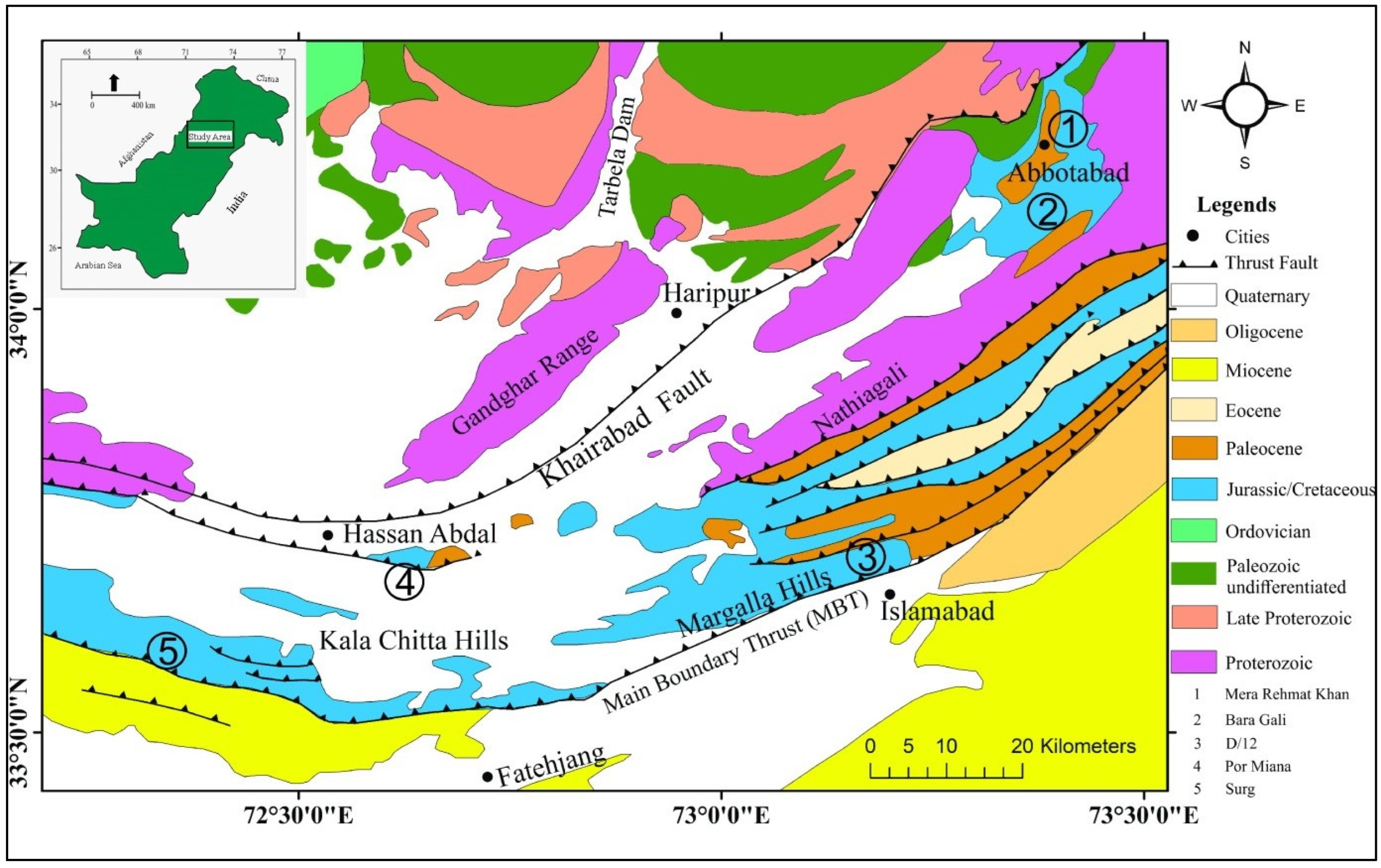
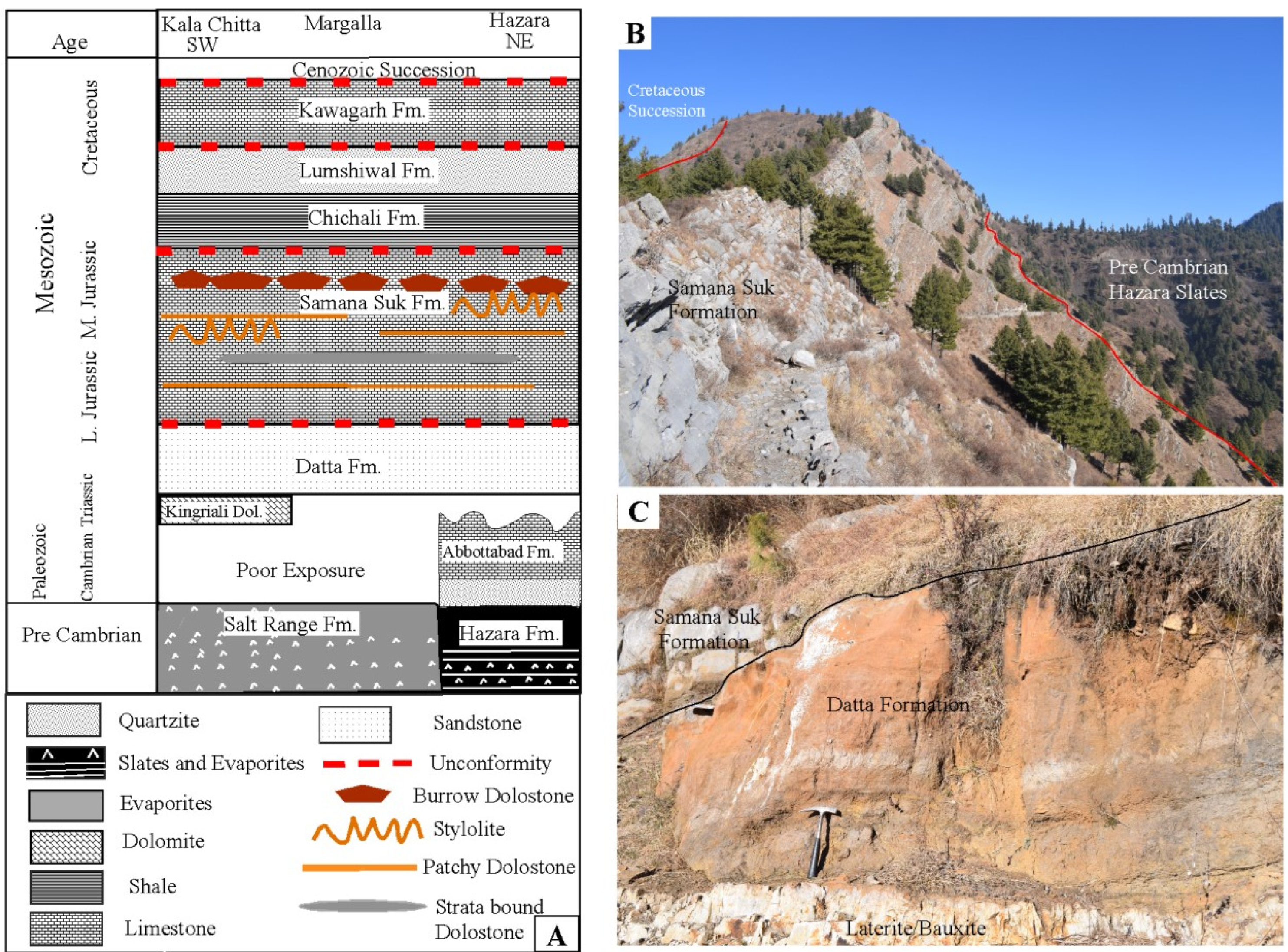
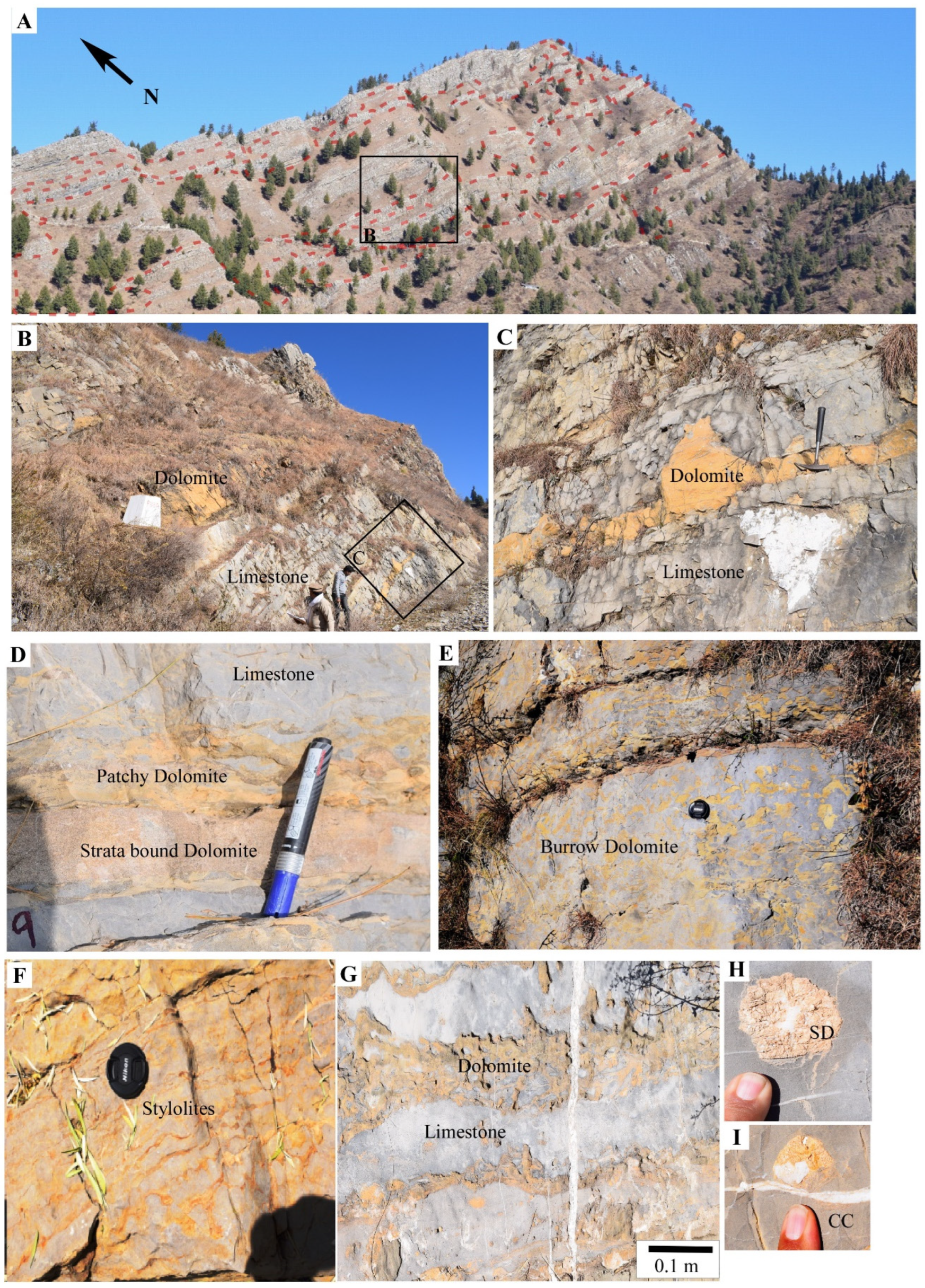
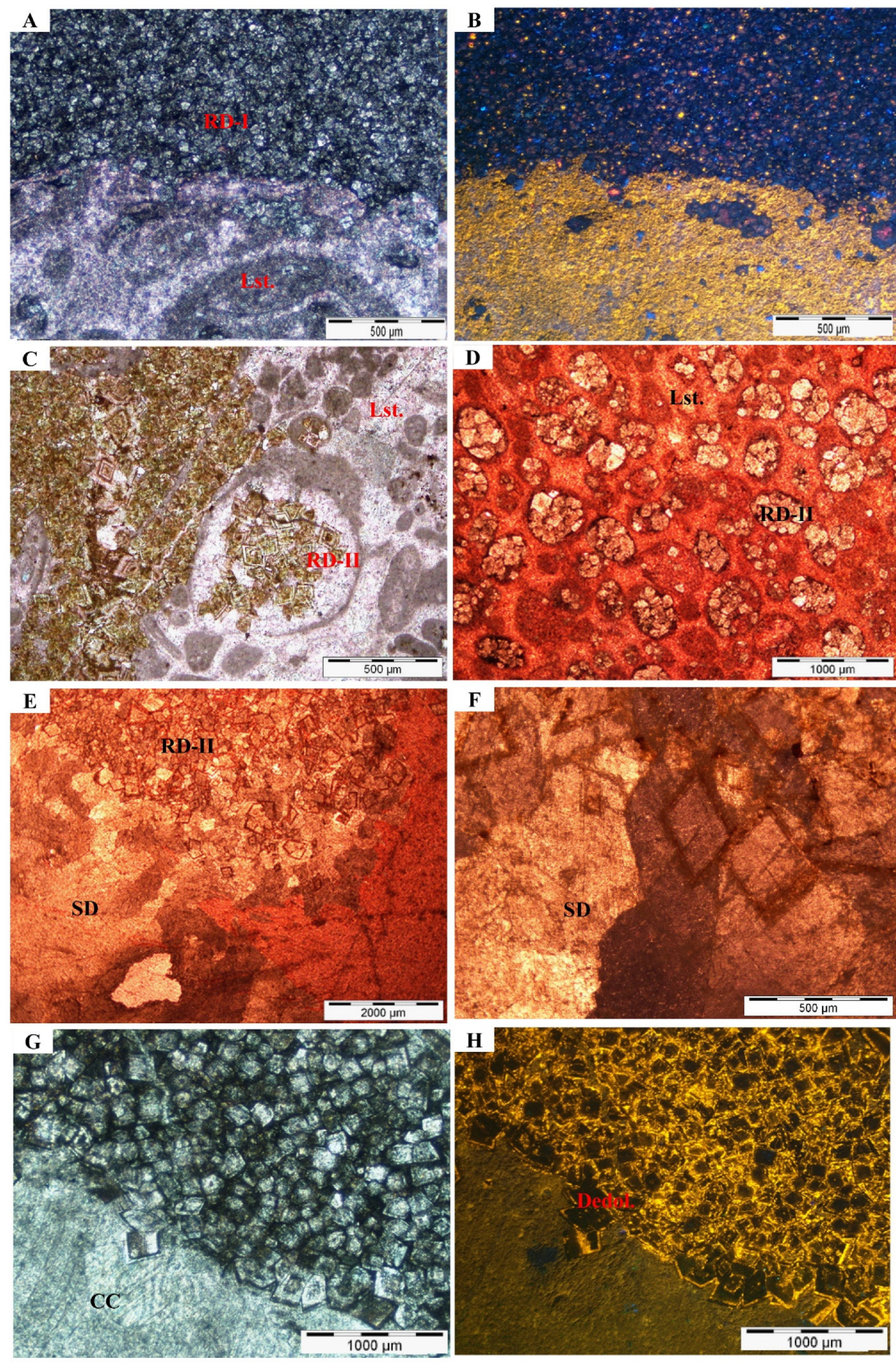


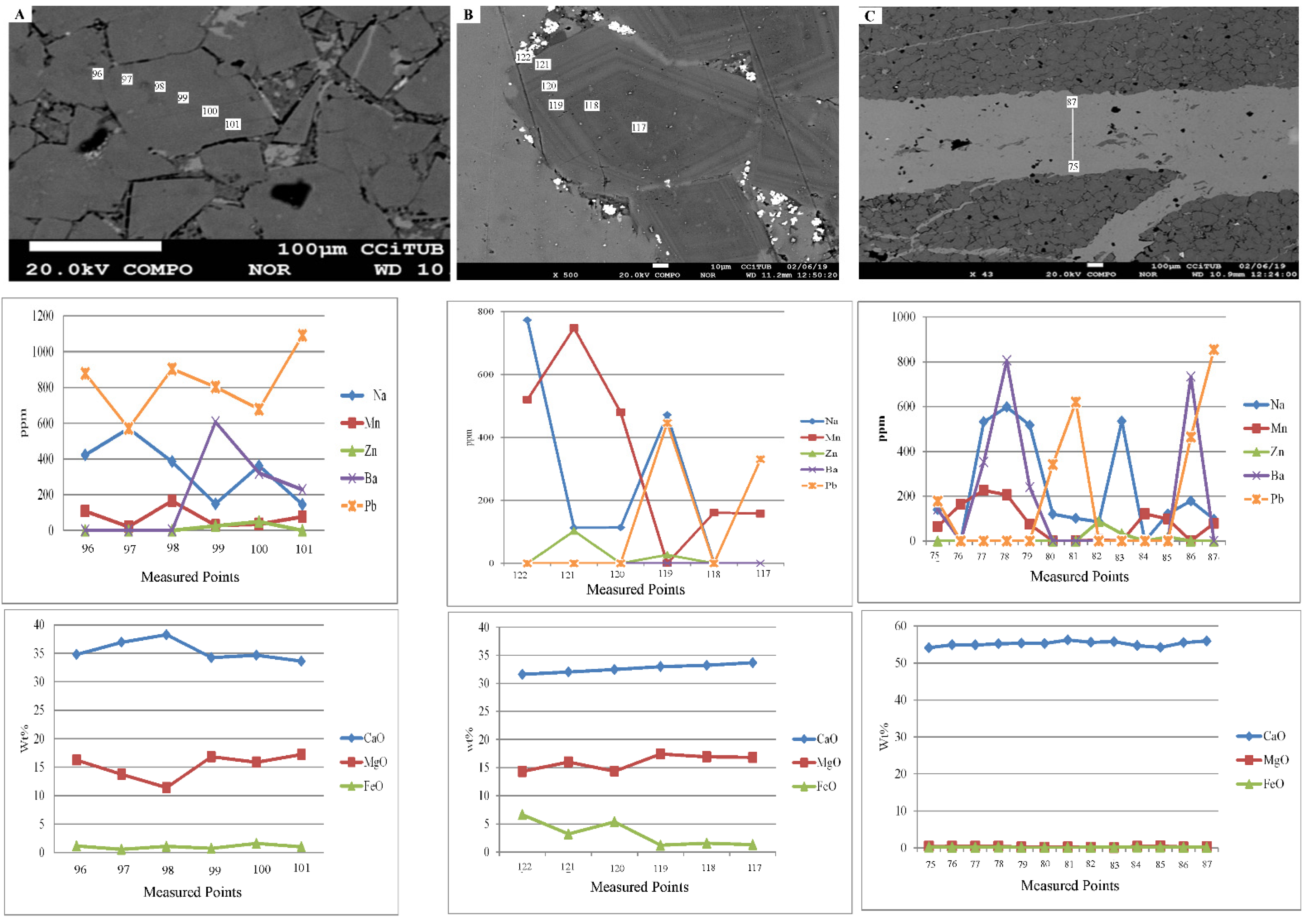
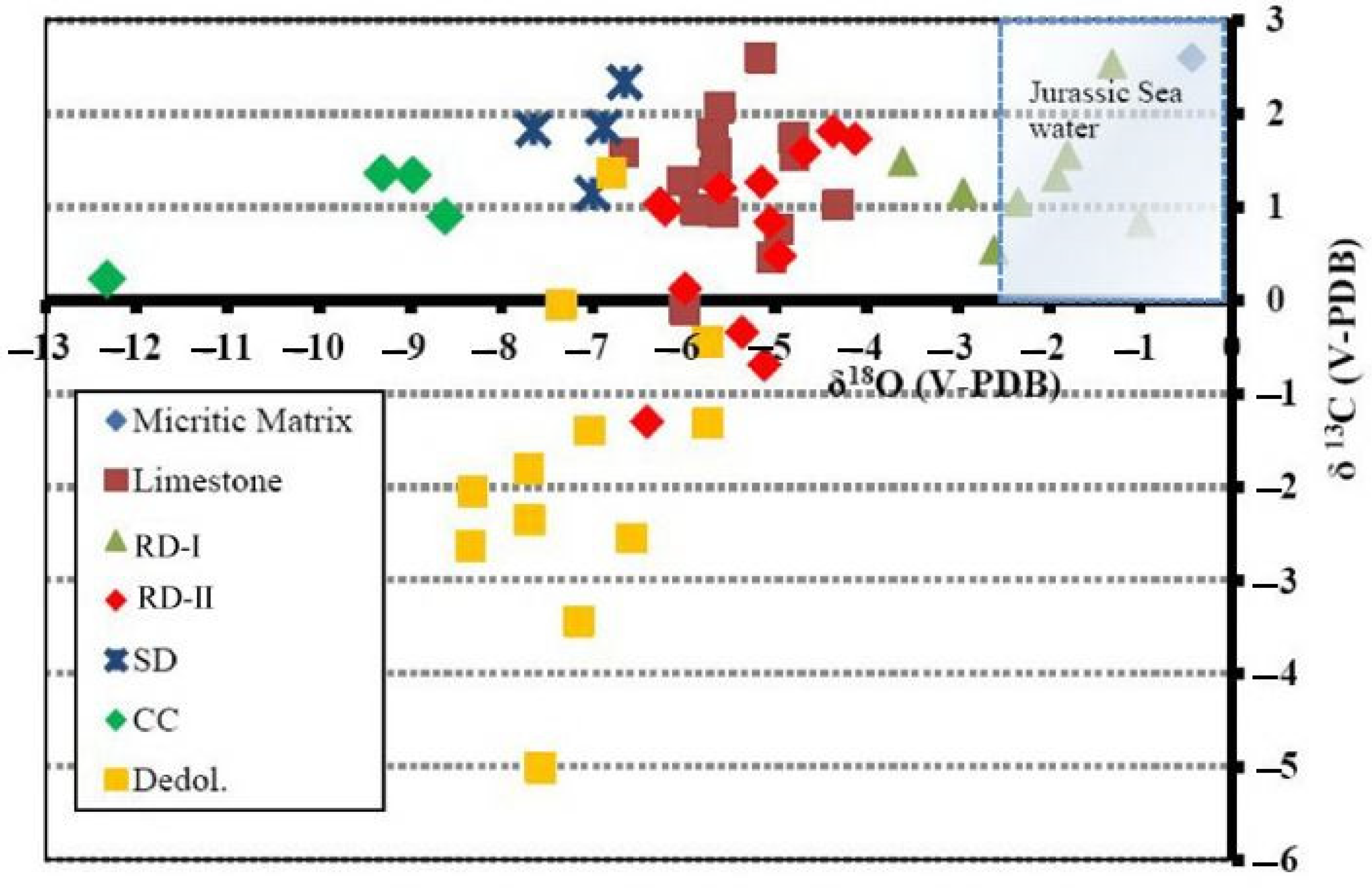
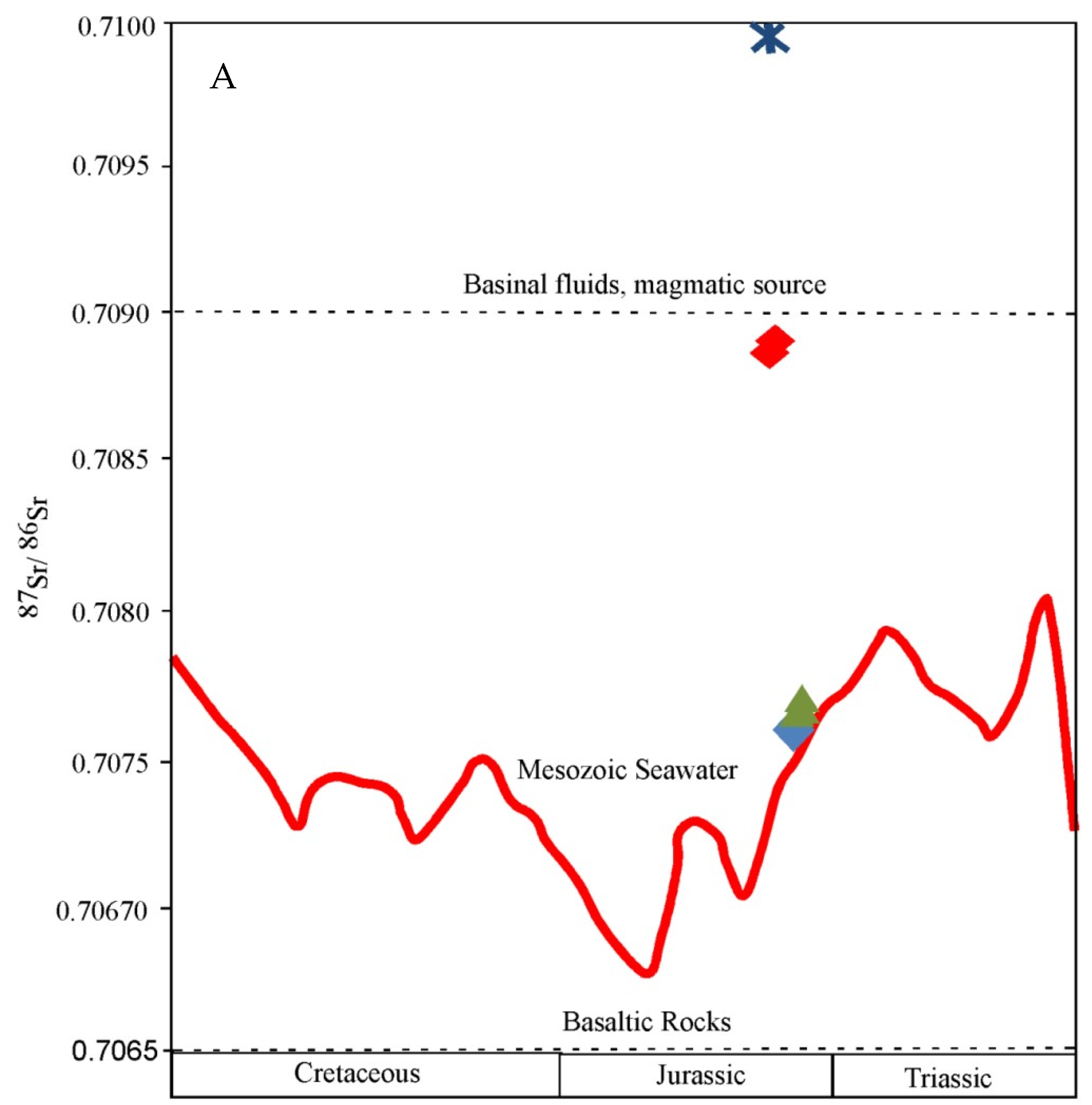
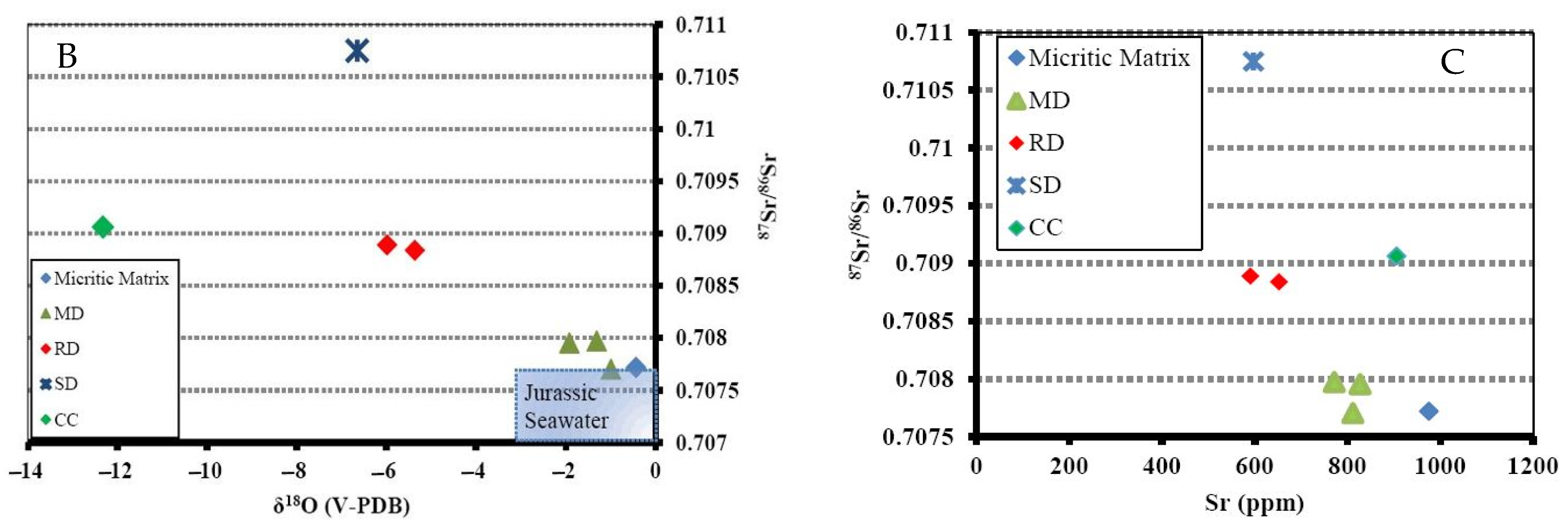
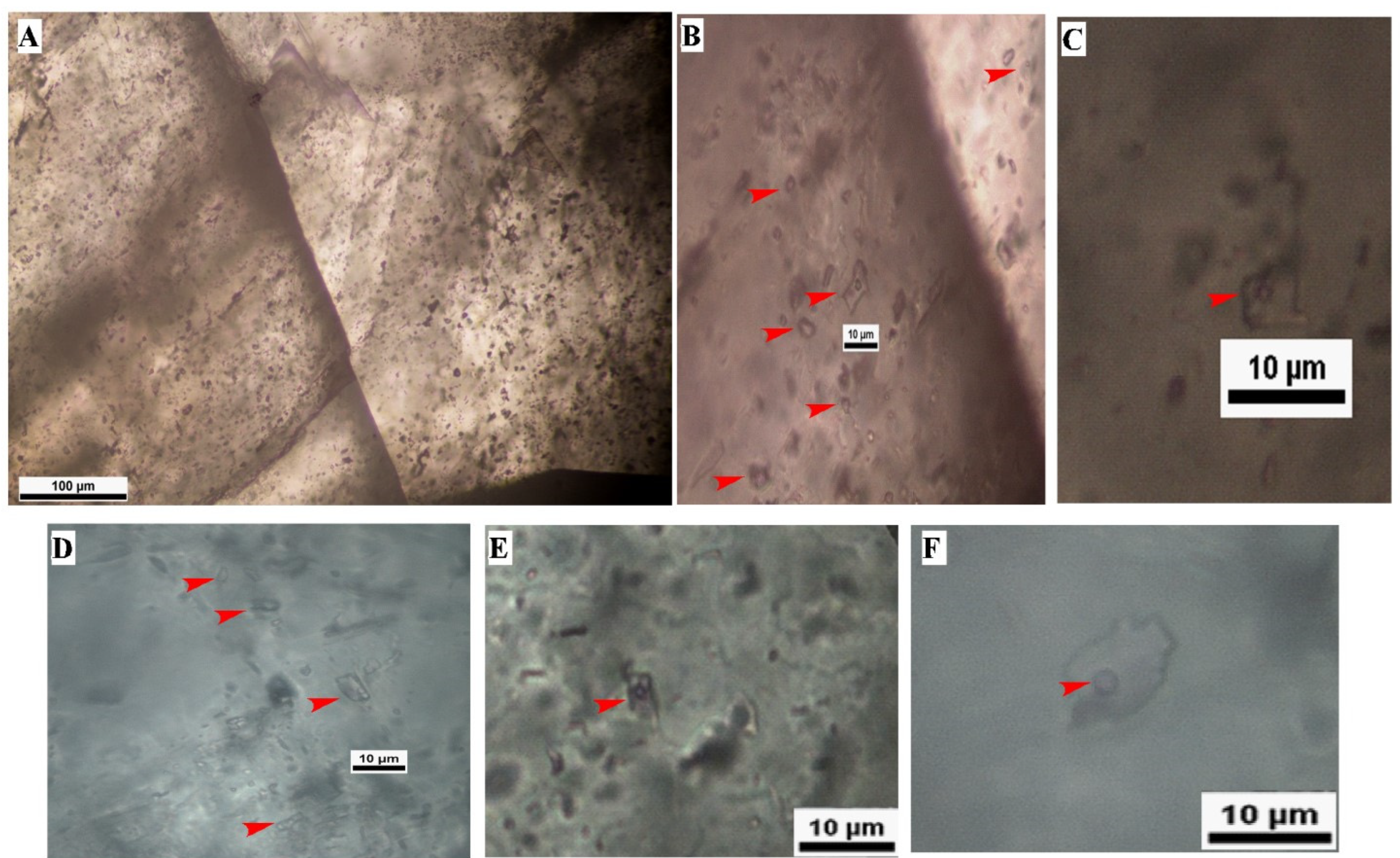

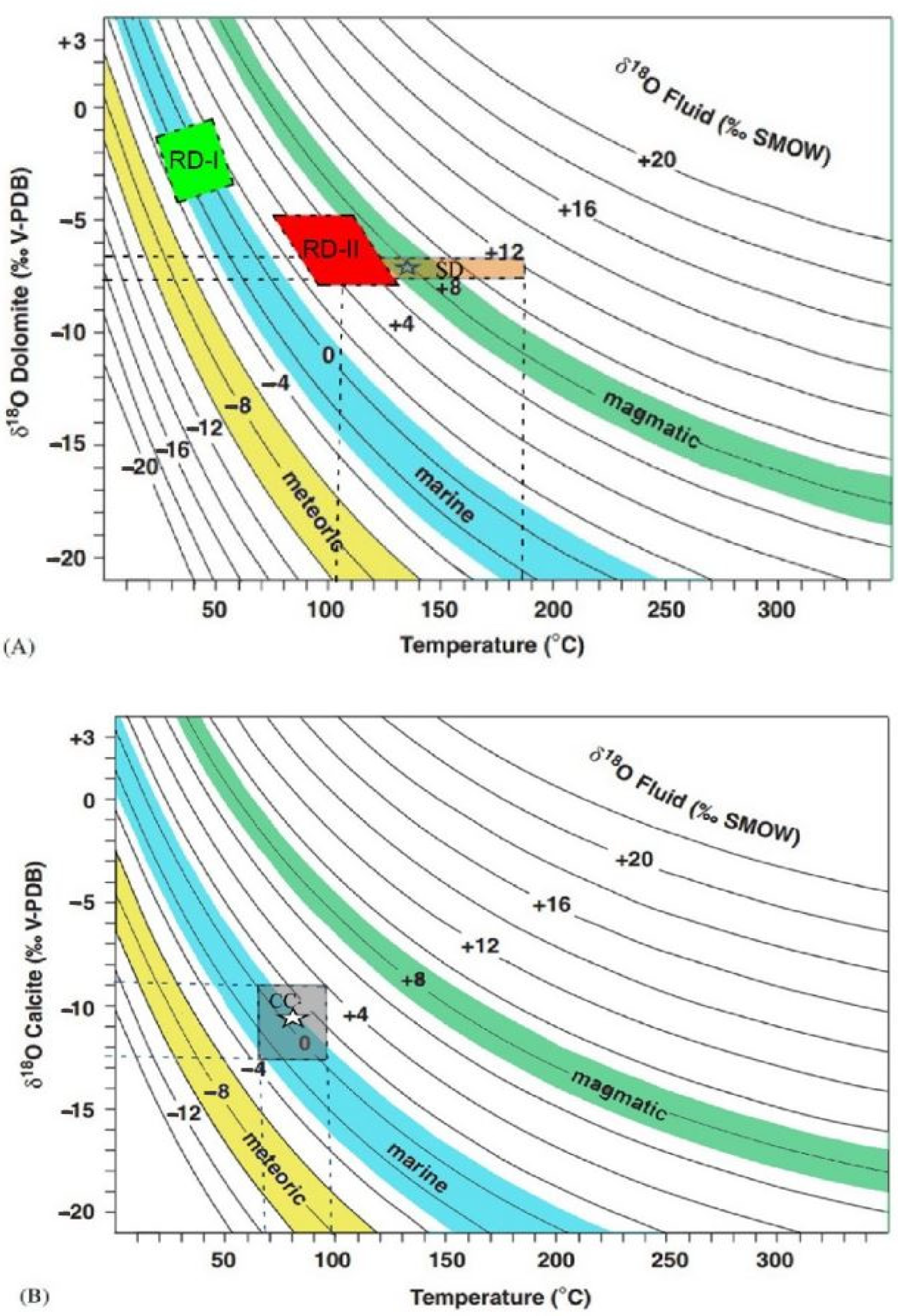
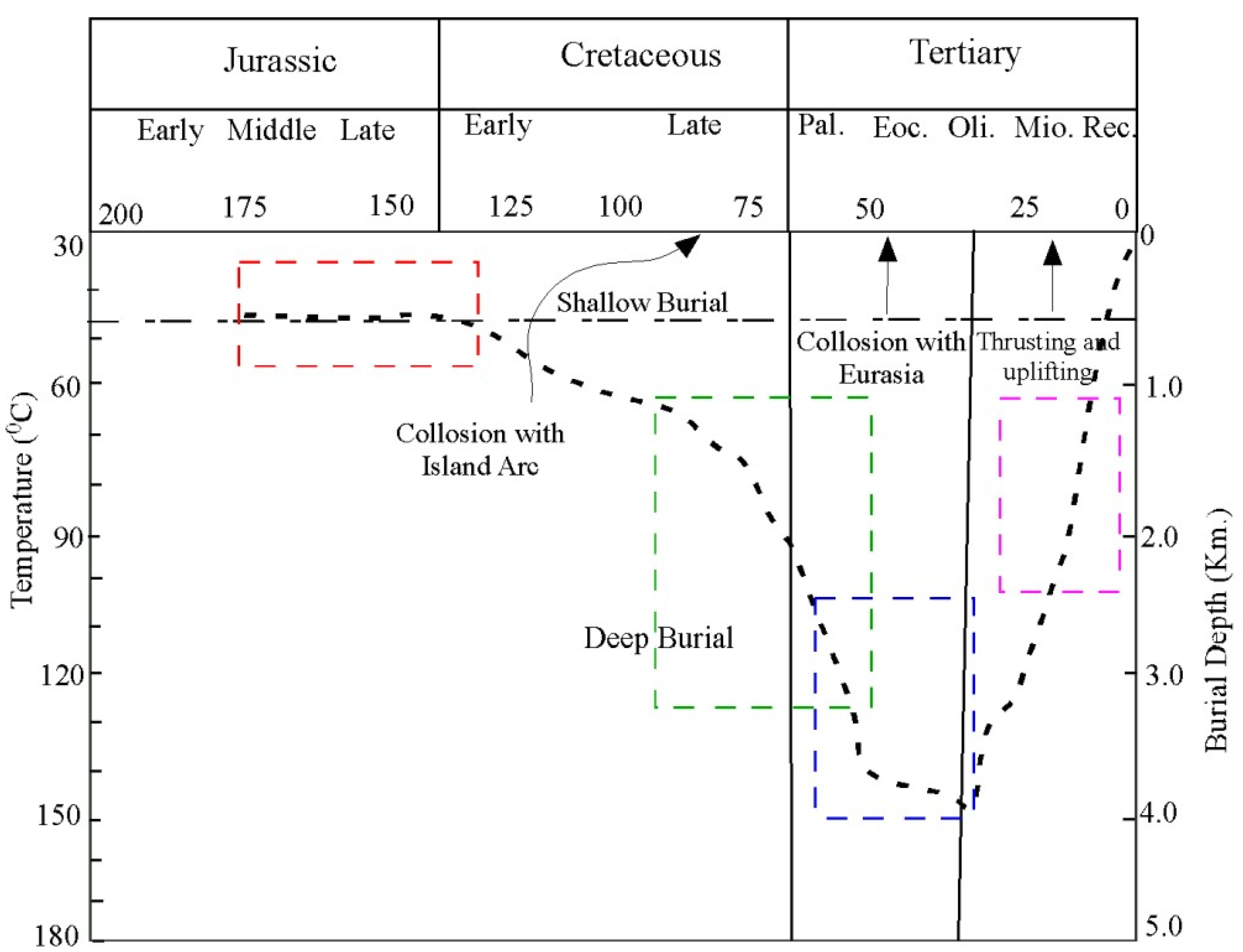
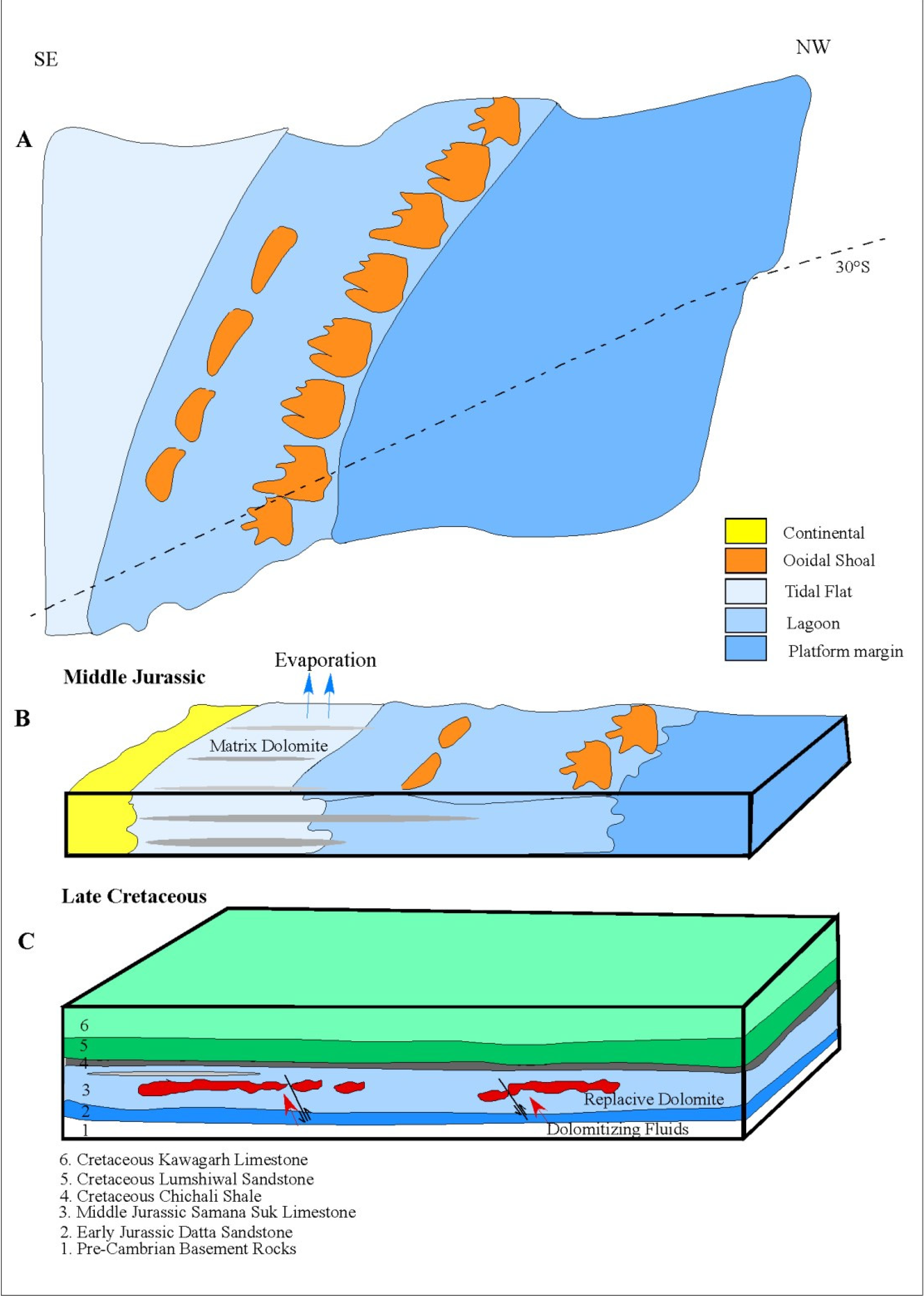
| Sr. No | Sample No | Phase | Point No | CaO Wt.% | MgO Wt.% | Na (ppm) | Fe (ppm) | Mn (ppm) | Zn (ppm) | Ba (ppm) |
|---|---|---|---|---|---|---|---|---|---|---|
| 1 | DS-17 | Host Limestone | 27 | 50.03 | 0.6055 | bdl | 2576 | 216 | bdl | bdl |
| 2 | DS-17 | Host Limestone | 32 | 45.99 | 8.64 | 258 | 11,815 | 0 | bdl | 682 |
| 3 | DS-17 | Host Limestone | 38 | 55.24 | 0.8165 | bdl | 1244 | 123 | bdl | bdl |
| 4 | DS-17 | Host Limestone | 39 | 54.82 | 0.4879 | 243 | 1283 | 153 | bdl | bdl |
| 5 | DS-17 | Host Limestone | 40 | 53.27 | 0.9339 | 647 | 6668 | 24 | 225 | bdl |
| 6 | DS-17 | Host Limestone | 57 | 55.39 | 0.3413 | 258 | 1002 | 231 | bdl | bdl |
| 7 | DS-17 | Host Limestone | 45 | 53.99 | 1.2727 | bdl | 2040 | 248 | bdl | bdl |
| 8 | DS-17 | Host Limestone | 46 | 55.32 | 0.16 | bdl | 721 | 84 | bdl | bdl |
| 9 | DS-17 | Host Limestone | 66 | 55.01 | 0.4679 | 127 | 1673 | 222 | bdl | bdl |
| 10 | DS-17 | Host Limestone | 73 | 54.63 | 0.8177 | bdl | 1684 | 89 | 0 | bdl |
| 11 | DS-17 | Host Limestone | 74 | 54.97 | 0.5624 | 142 | 1606 | 139 | bdl | bdl |
| 12 | MR-12 | Host Limestone | 106 | 54.32 | 0.5577 | 506 | 1228 | bdl | 0 | bdl |
| 13 | MR-12 | Host Limestone | 107 | 53.87 | 0.7406 | bdl | 1152 | 197 | 0 | bdl |
| 14 | MR-12 | Host Limestone | 108 | 53.89 | 0.4652 | 573 | 2291 | 137 | 8 | bdl |
| 15 | MR-12 | Host Limestone | 109 | 53.37 | 0.5793 | 550 | 1714 | 192 | 172 | bdl |
| 16 | MR-8 | Host Limestone | 141 | 52.67 | 0.9402 | 175 | 1723 | 608 | 0 | bdl |
| 17 | MR-8 | Host Limestone | 142 | 55.23 | 0.4701 | 320 | 1109 | bdl | 230 | bdl |
| 18 | MR-8 | Host Limestone | 143 | 54.19 | 0.4582 | 886 | 1020 | 202 | 0 | bdl |
| 19 | MR-8 | Host Limestone | 144 | 59.57 | 0.5598 | 525 | 1058 | bdl | 287 | bdl |
| 20 | DS-17 | RD-I | 26 | 32.78 | 17.14 | 634 | 10,105 | 261 | bdl | bdl |
| 21 | DS-17 | RD-I | 28 | 32.94 | 16.96 | 477 | 15,468 | 651 | bdl | bdl |
| 22 | DS-17 | RD-I | 29 | 33.85 | 16.44 | 655 | 15,391 | 368 | bdl | bdl |
| 23 | DS-17 | RD-I | 30 | 32.97 | 17.77 | 470 | 8375 | 83 | bdl | bdl |
| 24 | DS-17 | RD-I | 31 | 32.35 | 18.55 | 138 | 6985 | 264 | bdl | bdl |
| 25 | DS-17 | RD-I | 34 | 33 | 17.03 | 135 | 11,193 | 182 | bdl | bdl. |
| 26 | DS-17 | RD-I | 35 | 33.4 | 17.69 | bdl | 7733 | 303 | bdl | bdl. |
| 27 | DS-17 | RD-I | 36 | 32.68 | 18.33 | 438 | 5010 | 243 | 183 | bdl |
| 28 | DS-17 | RD-I | 37 | 32.45 | 17.09 | 524 | 6368 | 98 | 0 | bdl |
| 29 | DS-17 | RD-I | 41 | 32.49 | 17.81 | 390 | 17,101 | 298 | bdl | bdl |
| 30 | DS-17 | RD-I | 42 | 32.26 | 17.32 | 473 | 11,660 | 343 | bdl | bdl |
| 31 | DS-17 | RD-I | 43 | 32.87 | 17.76 | 729 | 7484 | 426 | bdl | bdl |
| 32 | DS-17 | RD-I | 44 | 32.35 | 18.36 | 680 | 10,882 | 346 | bdl | bdl |
| 33 | DS-17 | RD-I | 47 | 33.14 | 17.82 | 961 | 108,04 | 218 | bdl | 189 |
| 34 | DS-17 | RD-I | 52 | 32.47 | 16.8 | 1003 | 13,836 | 229 | 167 | 498 |
| 35 | DS-17 | RD-I | 53 | 32.89 | 17.59 | 398 | 8874 | 315 | 0 | 337 |
| 36 | DS-17 | RD-I | 54 | 33.11 | 18.09 | 520 | 6839 | 147 | bdl | 0 |
| 37 | DS-17 | RD-I | 55 | 33.33 | 17.51 | 1194 | 5832 | 54 | 118 | 0 |
| 38 | DS-17 | RD-I | 61 | 33.03 | 17.74 | 421 | 11,426 | 341 | 2 | 0 |
| 39 | DS-17 | RD-I | 62 | 30.8 | 17.91 | 1396 | 10,882 | 240 | 0 | 271 |
| 40 | DS-17 | RD-I | 63 | 30.82 | 18.01 | 345 | 12,437 | 232 | 134 | 156 |
| 41 | DS-17 | RD-I | 64 | 33.43 | 17.08 | 607 | 7376 | 348 | 132 | 0 |
| 42 | DS-17 | RD-I | 70 | 32.44 | 17.45 | 755 | 15,002 | 354 | 0 | 0 |
| 43 | DS-17 | RD-I | 71 | 31 | 18.38 | 357 | 12,048 | 364 | 180 | 119 |
| 44 | DS-17 | RD-I | 72 | 33.54 | 17.86 | 361 | 7886 | 387 | 0 | 751 |
| 45 | DS-17 | RD-I | 88 | 33.79 | 17.04 | 324 | 4159 | 54 | 0 | 0 |
| 46 | MR-12 | RD-I | 90 | 34.63 | 16.31 | 859 | 7681 | 157 | 0 | 343 |
| 47 | MR-12 | RD-I | 91 | 32.97 | 17.29 | 887 | 7461 | 0 | 0 | 528 |
| 48 | MR-12 | RD-I | 96 | 34.81 | 16.27 | 422 | 9176 | 108 | 0 | 0 |
| 49 | MR-12 | RD-I | 97 | 36.95 | 13.76 | 570 | 4529 | 21 | 0 | 0 |
| 50 | MR-12 | RD-I | 98 | 38.28 | 11.43 | 385 | 8708 | 365 | 0 | 0 |
| 51 | MR-12 | RD-I | 99 | 34.26 | 16.84 | 148 | 5803 | 28 | 25 | 606 |
| 52 | MR-12 | RD-I | 100 | 34.69 | 15.87 | 361 | 12,670 | 35 | 49 | 321 |
| 53 | MR-12 | RD-I | 101 | 33.63 | 17.24 | 198 | 8002 | 76 | 0 | 228 |
| 54 | MR-12 | RD-I | 110 | 33.7 | 16.68 | 566 | 9732 | 75 | bdl | 0 |
| 55 | MR-12 | RD-I | 111 | 32.67 | 18.19 | 318 | 7756 | 169 | 0 | 0 |
| 56 | MR-8 | RD-II | 112 | 33.53 | 16.75 | 653 | 10,416 | 39 | 0 | 0 |
| 57 | MR-8 | RD-II | 113 | 32.97 | 16.69 | 65 | 16,556 | 209 | 55 | 260 |
| 58 | MR-8 | RD-II | 114 | 32.56 | 17.61 | 275 | 10,804 | 113 | bdl | 554 |
| 59 | MR-8 | RD-II | 115 | 32.41 | 16.04 | 35 | 22,075 | 255 | 255 | 0 |
| 60 | MR-8 | RD-II | 116 | 31.93 | 13.91 | 66 | 52,312 | 505 | bdl | 0 |
| 61 | MR-8 | RD-II | 117 | 33.69 | 16.85 | 341 | 10,338 | 158 | 0 | 0 |
| 62 | MR-8 | RD-II | 118 | 33.21 | 16.94 | 0 | 12,359 | 161 | 0 | 0 |
| 63 | MR-8 | RD-II | 119 | 32.99 | 17.45 | 472 | 9444 | bdl. | 27 | 0 |
| 64 | MR-8 | RD-II | 120 | 32.47 | 14.39 | 114 | 41,819 | 480 | 0 | 0 |
| 65 | MR-8 | RD-II | 121 | 32.04 | 16.03 | 113 | 25,029 | 748 | 103 | 0 |
| 66 | MR-8 | RD-II | 122 | 31.6 | 14.34 | 773 | 51,846 | 520 | 0 | 0 |
| 67 | MR-8 | RD-II | 124 | 33.55 | 16.98 | 359 | 10,727 | 204 | 0 | 435 |
| 68 | MR-12 | CC | 75 | 54.09 | 0.3762 | 140 | 1522 | 65 | 0 | 140 |
| 69 | MR-12 | CC | 76 | 54.9 | 0.4391 | 0 | 1164 | 164 | 0 | 0 |
| 70 | MR-12 | CC | 77 | 54.85 | 0.4401 | 532 | 1119 | 226 | bdl | 352 |
| 71 | MR-12 | CC | 78 | 55.17 | 0.4364 | 598 | 1542 | 206 | bdl | 806 |
| 72 | MR-12 | CC | 79 | 55.32 | 0.2264 | 517 | 899 | 74 | bdl | 240 |
| 73 | MR-12 | CC | 80 | 55.24 | 0.1728 | 120 | 893 | bdl | bdl | 0 |
| 74 | MR-12 | CC | 81 | 56.18 | 0.203 | 101 | 818 | bdl | bdl | 0 |
| 75 | MR-12 | CC | 82 | 55.58 | 0.1677 | 86 | 1304 | 5 | 88 | bdl. |
| 76 | MR-12 | CC | 83 | 55.74 | 0.0642 | 535 | 993 | 132 | 32 | 0 |
| 77 | MR-12 | CC | 84 | 54.67 | 0.41 | 0 | 1021 | 122 | bdl | 0 |
| 78 | MR-12 | CC | 85 | 54.18 | 0.4903 | 121 | 1120 | 98 | bdl | bdl |
| 79 | MR-12 | CC | 86 | 55.49 | 0.2175 | 179 | 1325 | 0 | bdl | 734 |
| 80 | MR-12 | CC | 87 | 55.92 | 0.3308 | 97 | 1349 | 79 | bdl | bdl |
| 81 | MR-6 | Dedol. | 4 | 54.31 | 0.6358 | 872 | 3170 | 308 | 0 | 301 |
| 82 | MR-6 | Dedol | 5 | 55.13 | 0.5372 | 297 | 1576 | 143 | 0 | 542 |
| 83 | MR-6 | Dedol. | 6 | 53.19 | 0.8163 | 617 | 2301 | 535 | 0 | bdl |
| 84 | MR-6 | Dedol | 7 | 55.18 | 0.3626 | 243 | 3607 | 191 | 279 | bdl |
| 85 | MR-6 | Dedol. | 8 | 55.2 | 0.3014 | 0 | 1769 | 133 | 0 | bdl |
| 86 | MR-6 | Dedol | 9 | 55.89 | 0.3703 | 0 | 1321 | 0 | 0 | bdl |
| 87 | MR-6 | Dedol. | 10 | 55.25 | 0.3096 | 266 | 637 | 185 | 200 | bdl |
| 88 | MR-6 | Dedol | 11 | 54.36 | 0.3116 | 0 | 4180 | 222 | 0 | bdl |
| 89 | MR-6 | Dedol. | 12 | 55.08 | 0.2513 | bdl | 1785 | 463 | 130 | bdl |
| 90 | MR-6 | Dedol | 21 | 54.4 | 0.6553 | 0 | 2414 | 413 | 0 | bdl |
| 91 | MR-6 | Dedol. | 22 | 53.78 | 0.7344 | 342 | 2203 | 150 | 76 | bdl |
| 92 | MR-6 | Dedol. | 23 | 53.55 | 1.0515 | 264 | 4244 | 550 | 285 | bdl |
| 93 | MR-6 | Dedol. | 24 | 54.16 | 0.4847 | 0 | 7684 | 263 | 0 | bdl |
| Sr. No | Sample Code. | Phase | δ 13C ‰ (V-PDB) | δ 18O ‰ (V-PDB) | 87Sr/86Sr (±σ) |
|---|---|---|---|---|---|
| 1 | PM-24-A | Micritic Matrix | 2.59 | −0.44 | 0.707718 |
| 2 | PM-5A | Limestone | −0.11 | −5.99 | |
| 3 | PM-28-A | Limestone | 1.44 | −5.16 | |
| 4 | PM-33-A | Limestone | 0.97 | −5.65 | |
| 5 | PM-44-A | Limestone | 0.76 | −5.87 | |
| 6 | PM-77A1 | Limestone | 1.78 | −5.61 | |
| 7 | PM-77A2 | Limestone | 1.83 | −5.67 | |
| 8 | BG-2A | Limestone | 0.94 | −4.96 | |
| 9 | BG-15A | Limestone | 1.02 | −5.57 | |
| 10 | KS-14 | Rudist Shells/ Limestone | 1.28 | −4.31 | |
| 11 | KS-15A | Limestone | 1.58 | −5.04 | |
| 12 | KS-16A | Limestone | 1.36 | −6.01 | |
| 13 | MR-12A | Limestone | 1.58 | −5.67 | |
| 14 | MR-13A | Limestone | 1.56 | −5.65 | |
| 15 | MR-26A | Limestone | 1.74 | −4.79 | |
| 16 | MR-26B | Limestone | 2.07 | −4.80 | |
| 17 | PM-10A | RD-I | 1.05 | −2.34 | |
| 18 | PM-10B | RD-I | 1.15 | −2.94 | |
| 19 | PM-23C | RD-I | 3.19 | −0.99 | 0.707703 |
| 20 | PM-33-B | RD-I | 0.53 | −2.60 | |
| 21 | BG-15B | RD-I | 1.29 | −3.60 | |
| 22 | BG-22A | RD-I | 1.48 | −1.92 | 0.707952 |
| 23 | MR-12B | RD-I | 2.52 | −1.31 | 0.707972 |
| 24 | KS-9 | RD-I | 1.32 | 1.8 | |
| 25 | PM-20A | RD-II | 1.81 | −4.37 | |
| 26 | PM-24B | RD-II | 1.59 | −4.68 | |
| 27 | PM-63-A | RD-II | −1.3 | −6.41 | |
| 28 | PM-77B | RD-II | −0.35 | −5.37 | 0.708839 |
| 29 | PM-77B1 | RD-II | 1.26 | −5.15 | |
| 30 | PM-77B2 | RD-II | 0.47 | −4.68 | |
| 31 | PM-77B3 | RD-II | 0.51 | −4.69 | |
| 32 | BG-6A | RD-II | 0.47 | −4.95 | |
| 33 | BG-8A | RD-II | 0.12 | −5.99 | 0.70889 |
| 34 | BG-9B | RD-II | 0.97 | −6.21 | |
| 35 | BG-12A | RD-II | −0.69 | −5.12 | |
| 36 | KS-17A | RD-II | 1.73 | −4.122 | |
| 37 | KS-18B | RD-II | 1.03 | −6.26 | |
| 38 | PM-23A | SD | 1.85 | −6.88 | |
| 39 | PM-49A | SD | 1.83 | −7.64 | |
| 40 | MR-2A | SD | 1.39 | −7.00 | |
| 41 | MR-37A | SD | 2.34 | −6.65 | 0.710747 |
| 42 | BG-12B | CC | 1.36 | −9.38 | |
| 43 | KS-15B | CC | 1.34 | −12.32 | 0.709061 |
| 44 | KS-17B | CC | 0.90 | −8.97 | |
| 45 | MR-2B | CC | 0.23 | −8.61 | |
| 46 | PM-2 | Dedol. | −2.36 | −7.69 | |
| 47 | PM-7A | Dedol. | −2.55 | −6.57 | |
| 48 | PM-44-B | Dedol. | −2.64 | −8.34 | |
| 49 | PM-79A | Dedol. | −3.45 | −7.15 | |
| 50 | PM-83A | Dedol. | −5.01 | −7.57 | |
| 51 | PM-85A | Dedol. | −0.06 | −7.35 | |
| 52 | PM-86 | Dedol. | −2.06 | −8.32 | |
| 53 | BG-5B | Dedol. | −1.32 | −5.74 | |
| 54 | BG-7A | Dedol. | −0.45 | −7.04 | |
| 55 | KS-1 | Dedol | −1.4 | −7.7 | |
| 56 | KS-15C | Dedol | −1.80 | −6.79 | |
| 57 | KS-16B | Dedol. | 1.36 | 6.78 |
| Sr. No | Sample No | Phase | Th | Tmi | Eq. Wt.% NaCl |
|---|---|---|---|---|---|
| 1 | MR-37 | Saddle Dolomite(SD) | 118.6 | −12.0 | 16.0 |
| 2 | MR-37 | Saddle Dolomite(SD) | 119.6 | −11.0 | 15.0 |
| 3 | MR-37 | Saddle Dolomite(SD) | 121.0 | −8.0 | 11.7 |
| 4 | MR-37 | Saddle Dolomite(SD) | 122.5 | −11.0 | 15.0 |
| 5 | MR-37 | Saddle Dolomite(SD) | 110.4 | −16.0 | 19.4 |
| 6 | MR-37 | Saddle Dolomite(SD) | 108.4 | −15.0 | 18.6 |
| 7 | MR-37 | Saddle Dolomite(SD) | 119.7 | −14.0 | 17.8 |
| 8 | MR-37 | Saddle Dolomite(SD) | 131.7 | −15.0 | 18.6 |
| 9 | MR-37 | Saddle Dolomite(SD) | 137.6 | −15.0 | 18.6 |
| 10 | MR-37 | Saddle Dolomite(SD) | 125.4 | −13.0 | 16.9 |
| 11 | MR-37 | Saddle Dolomite(SD) | 127.6 | −15.5 | 19.0 |
| 12 | MR-21 | Saddle Dolomite(SD) | 122.8 | −14.0 | 17.8 |
| 13 | MR-37 | Saddle Dolomite(SD) | 124.8 | −12.0 | 16.0 |
| 14 | MR-37 | Saddle Dolomite(SD) | 121.0 | −9.0 | 12.8 |
| 15 | MR-37 | Saddle Dolomite(SD) | 126.0 | −13.0 | 16.9 |
| 16 | MR-37 | Saddle Dolomite(SD) | 129.8 | −15.0 | 18.6 |
| 17 | MR-37 | Saddle Dolomite(SD) | 102.8 | −14.0 | 17.8 |
| 18 | MR-37 | Saddle Dolomite(SD) | 180.5 | −15.0 | 18.6 |
| 19 | MR-37 | Saddle Dolomite(SD) | 186.0 | −13.0 | 16.9 |
| 20 | MR-37 | Saddle Dolomite(SD) | 169.0 | −15.0 | 18.6 |
| 21 | MR-37 | Saddle Dolomite(SD) | 171.0 | −15.0 | 18.6 |
| 22 | KS-15 | Hydrothermal Calcite | 92.4 | −8.0 | 11.7 |
| 23 | KS-15 | Hydrothermal Calcite | 92.6 | -- | |
| 24 | KS-15 | Hydrothermal Calcite | 93.8 | −8.4 | 12.2 |
| 25 | KS-15 | Hydrothermal Calcite | 98.4 | −9.2 | 13.1 |
| 26 | KS-15 | Hydrothermal Calcite | 86.4 | −6.5 | 9.9 |
| 27 | KS-15 | Hydrothermal Calcite | 89.5 | −7.9 | 11.6 |
| 28 | KS-15 | Hydrothermal Calcite | 82.4 | −5.9 | 9.1 |
| 29 | KS-15 | Hydrothermal Calcite | 85.9 | −6.2 | 9.5 |
| 30 | KS-15 | Hydrothermal Calcite | 88.7 | −8.3 | 12.0 |
| 31 | KS-15 | Hydrothermal Calcite | 87.8 | −8.1 | 11.8 |
| 32 | KS-15 | Hydrothermal Calcite | 78.6 | −5.8 | 8.9 |
| 33 | KS-15 | Hydrothermal Calcite | 73.5 | −4.8 | 7.6 |
| 34 | KS-15 | Hydrothermal Calcite | 77.9 | −5.5 | 8.5 |
| 35 | KS-15 | Hydrothermal Calcite | 76.6 | −5.8 | 8.9 |
| 36 | KS-15 | Hydrothermal Calcite | 68.0 | −4.3 | 6.9 |
Publisher’s Note: MDPI stays neutral with regard to jurisdictional claims in published maps and institutional affiliations. |
© 2022 by the authors. Licensee MDPI, Basel, Switzerland. This article is an open access article distributed under the terms and conditions of the Creative Commons Attribution (CC BY) license (https://creativecommons.org/licenses/by/4.0/).
Share and Cite
Rahim, H.-u.-; Qamar, S.; Shah, M.M.; Corbella, M.; Martín-Martín, J.D.; Janjuhah, H.T.; Navarro-Ciurana, D.; Lianou, V.; Kontakiotis, G. Processes Associated with Multiphase Dolomitization and Other Related Diagenetic Events in the Jurassic Samana Suk Formation, Himalayan Foreland Basin, NW Pakistan. Minerals 2022, 12, 1320. https://doi.org/10.3390/min12101320
Rahim H-u-, Qamar S, Shah MM, Corbella M, Martín-Martín JD, Janjuhah HT, Navarro-Ciurana D, Lianou V, Kontakiotis G. Processes Associated with Multiphase Dolomitization and Other Related Diagenetic Events in the Jurassic Samana Suk Formation, Himalayan Foreland Basin, NW Pakistan. Minerals. 2022; 12(10):1320. https://doi.org/10.3390/min12101320
Chicago/Turabian StyleRahim, Hamad-ur-, Shazia Qamar, Mumtaz Muhammad Shah, Mercè Corbella, Juan Diego Martín-Martín, Hammad Tariq Janjuhah, Dídac Navarro-Ciurana, Vasiliki Lianou, and George Kontakiotis. 2022. "Processes Associated with Multiphase Dolomitization and Other Related Diagenetic Events in the Jurassic Samana Suk Formation, Himalayan Foreland Basin, NW Pakistan" Minerals 12, no. 10: 1320. https://doi.org/10.3390/min12101320
APA StyleRahim, H.-u.-, Qamar, S., Shah, M. M., Corbella, M., Martín-Martín, J. D., Janjuhah, H. T., Navarro-Ciurana, D., Lianou, V., & Kontakiotis, G. (2022). Processes Associated with Multiphase Dolomitization and Other Related Diagenetic Events in the Jurassic Samana Suk Formation, Himalayan Foreland Basin, NW Pakistan. Minerals, 12(10), 1320. https://doi.org/10.3390/min12101320









